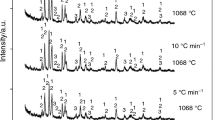The natural minerals of the Tebinbulak deposit, which are used as heat-insulation materials, were investigated. Their expansion coefficient depends on the raw grain size and ranges from 3.47 to 7.67. The structure of the material was studied by means of x-ray diffraction and infrared spectroscopy. The chemical composition was determined by the microprobe method, and the phase transformations on heating were determined by means of differential scanning calorimetry. The information obtained made it possible to conclude that this micaceous mineral is at the initial stage of metamorphism, i.e., a disordered interlayer structure of phlogopite/vermiculite (hydrophlogopite). This information is important for studying how the structure of hydromicas affects the possibility and nature of their swelling on heating.







Similar content being viewed by others
References
E. L. Popov, Kh. Akhmedov, and G. R. Khabibullaeva, “Results of technological studies of two samples of vermiculite ore from the Tebinbulak deposit,” Gornyi Vest. Uzbekistana, No. 4(43), 84 – 87 (2010).
G. M. Dosanova, N. Kh. Talipov, and I. A. Levitskii, “Characteristics of vermiculites of the Tebinbulak deposit of the Republic of Karakalpakstan,” in: 2nd Intern. Sci.-Tech. Conf. “Minsk Scientific Lectures – 2019” on Integration and Development of Scientific, Technical and Educational Cooperation: a Look into the Future: Minsk, December 11 – 12, 2019 [in Russian], BSTU, Minsk (2020) Vol. 2, pp. 62 – 66.
A. Campos, S. Moreno, and R. Molina, “Characterization of vermiculite by XRD and spectroscopic techniques,” Earth Sci. Res. J., 13(2), 108 – 118 (2009).
F. Bergaya, B. K. G. Theng, and G. Lagaly, Handbook of Clay Science, Elsevier, Oxford (2006).
A. D. Macheca, W. W. Focke, H. F. Muiambo, and M. Kaci, “Stiffening mechanisms in vermiculite–amorphous polyamide bio-nanocomposites,” Eurp. Polymer J., No. 74. 51 – 63 (2016).
G.W. Brindley, Patricia E. Zalba, and Craig M. Bethke, “Hydrobiotite, a regular 1 : 1 interstratification of biotite and vermiculite layers,” Am. Mineralogist, 68. 420 – 425 (1983).
D. Carroll, Clay Minerals: A Guide to Their x-ray Identification Geological Survey, The Geological Society of America, INC, Colorado (1970).
Olaosebikan Folorunso MSc, Microwave Processing of Vermiculite, Thesis submitted to the University of Nottingham for the degree of Doctor of Philosophy 20/03/2015, Nottingham (2015).
I. A. Lvova, Vermiculite Deposits in the USSR. Formational Types and Patterns of Placement [in Russian], Nedra, Leningrad (1974) (Proceedings of VSEGEI, Vol. 216).
R. Kikuchi and T. Kogure, “Structural and compositional variances in ‘hydrobiotite’ sample from Palabora, South Africa,” Clay Science, No. 22, 39 – 52 (2018).
S. Hillier, EMM Marwa, and CM Rice, “On the mechanism of exfoliation of Vermiculite,” Clay Minerals, No. 48. 563 – 582 (2013).
A. Beran, “Infrared spectroscopy of micas,” Rev. Mineralogy Geochem., 46, 350 – 369 (2002).
L. P. Nikitina, N. O. Ovchinnikov,M. S. Babushkina, et al., “Do mica rocks of the Archean complex of the Kola Superdeep wells retain information on the state of the crystal substance Fe–Mg of mica rock on being raised to the surface during drilling,” Vest. MGTU, 10(1), 37 – 49 (2007).
T. M. H. Costa, M. R. Gallas, E. V. Benvenutti, and J. A. H. da Jornada, “Infrared and thermogravimetric study of high pressure consolidation in alkoxide silica gel powders,” J. Non-Cryst. Solids, 220(2 – 3), 195 – 201 (1997).
F. M. Bulatov, Crystal Chemistry of Industrial Minerals in Solving Problems of Applied Mineralogy, Author’s Abstract of Doctoral’s Thesis [in Russian], Kazan State University, Kazan (2013).
Author information
Authors and Affiliations
Corresponding author
Additional information
Translated from Steklo i Keramika, No. 9, pp. 55 – 65, September, 2022.
Rights and permissions
Springer Nature or its licensor (e.g. a society or other partner) holds exclusive rights to this article under a publishing agreement with the author(s) or other rightsholder(s); author self-archiving of the accepted manuscript version of this article is solely governed by the terms of such publishing agreement and applicable law.
About this article
Cite this article
Rumi, M.K., Urazaeva, E.M., Nurmatov, S. et al. Mineralogical Aspects of Expanded Vermiculite Ores. Glass Ceram 79, 386–392 (2023). https://doi.org/10.1007/s10717-023-00518-4
Received:
Published:
Issue Date:
DOI: https://doi.org/10.1007/s10717-023-00518-4




